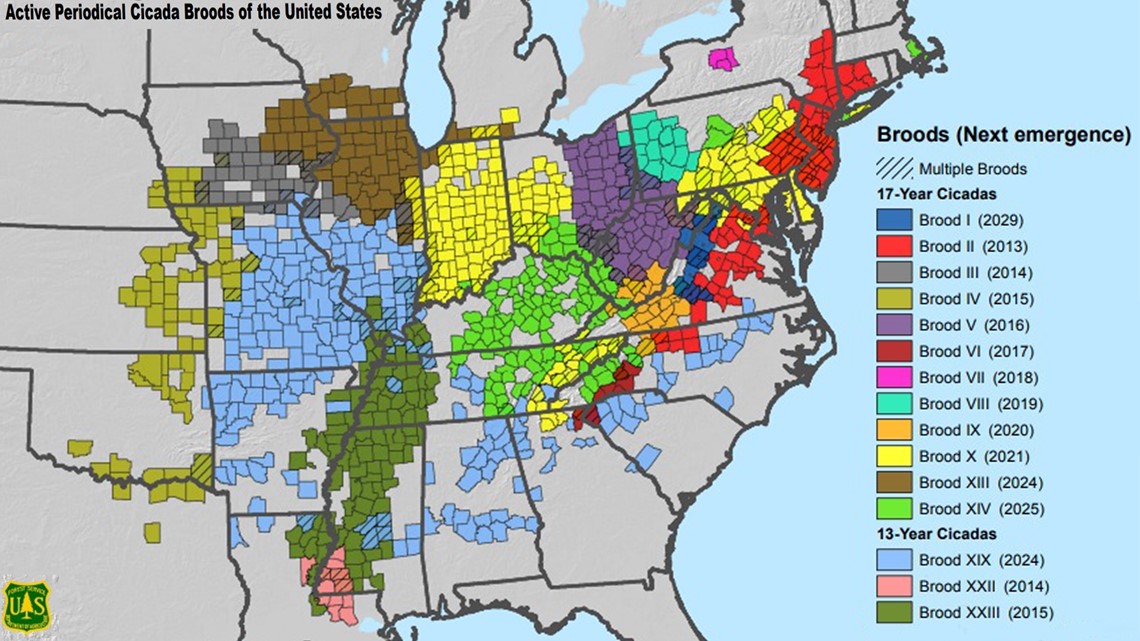ARKANSAS, USA — Trillions of cicadas are about to emerge across the U.S. during a once-in-a-lifetime co-emergence, and Arkansas is right in their path. Here's what you need to know.
What is a co-emergence and why is it special?
There are three main types of cicadas: annual, 13-year periodical, and 17-year periodical.
Co-emergences occur when a brood of 13-year cicadas emerge at the same time as a brood of 17-year cicadas.
While a co-emergence isn't necessarily uncommon thanks to how many cicada broods there are in the U.S., this one is special because it's the first time that these two broods, Brood 13 and 19, have co-emerged in 221 years.
This is the first co-emergence in general since 2015.
Not only that, but these two broods share boundaries in their emergence locations, which won't happen again until 2076. While overlap isn't predicted, researchers say that it is possible in some wooded areas, meaning that some rare areas of the country can experience annual cicadas, 13-year cicadas, and 17-year cicadas simultaneously.
Brood 19, a 13-year brood also known as the "Great Southern Brood," is one of the only cicada broods with a presence in Arkansas.


While Arkansas isn't near the touching boundaries, many residents of the Natural State will be able to experience annual cicadas and 13-year cicadas, with billions, or even trillions, of the colorful bugs expected to make an appearance.
According to a map from the U.S. Department of Agriculture, many counties in 5COUNTRY will experience the emergence, including Benton, Washington, Madison, Crawford, Franklin, Johnson, Sebastian, Logan, and Scott, as well as surrounding counties.
Cicadas emerge when the soil reaches around 64 degrees. Once that occurs, the bugs will begin to emerge, taking just weeks to fly around, make noise, eat, breed, lay eggs, and die.
To learn more about this emergence, click here.
What you need to know:
Cicadas are a favorite snack for an assortment of creatures found in Arkansas.
Here's how these extra cicadas are expected to interact with some members of the Natural State's ecosystem.
- Snakes — Snakes, such as copperheads, will come out of hiding to eat cicadas. While snake populations can see spikes due to the abundance of food, it will return to normal when the food source runs out.
- Birds — Cicada emergences are an "all-you-can-eat buffet" for birds, and some scientists theorize that more young birds make it to adulthood because of the extra food.
- Fish — Trout, bass, catfish, stripers, and carp are just a few types of fish that love eating cicadas, and some anglers recommend using live cicadas as bait.
Cicadas generally eat from small branches on trees, so most gardens and crops will be safe. Trees themselves shouldn't be harmed too much, either.
However, when cicadas emerge, they can leave holes in the ground from their burrows.
To learn more about how cicadas can affect Arkansas, click here.
How to spot them:
A general rule of thumb is that 13-year and 17-year cicadas have red eyes, while annual cicadas typically have yellow eyes.
Annual cicadas, also called "dog day" cicadas, typically emerge later in the summer as well.
Watch 5NEWS on YouTube.
Download the 5NEWS app on your smartphone:
Stream 5NEWS 24/7 on the 5+ app: How to watch the 5+ app on your streaming device
To report a typo or grammatical error, please email KFSMDigitalTeam@tegna.com and detail which story you're referring to.

